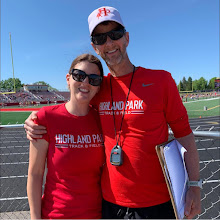Yesterday I was going over my race results for the year. I punched all my times into this WAVA calculator. I used to think age-grading was silly, but now that I “qualify” (36 years and older) I think it’s interesting. If nothing else, it allows me to compare race X to race Y.
If you’re not familiar with WAVA, it’s an age-grading system that allows you to punch in your age, sex, time and distance and it will give you such things as an age-graded result, which is your time if you were an Open runner and an age-performance percentage (the higher the better). It is this percentage that I used to analyze my races for the year;
2/5/05 70.55%
3/20/05 71.21%
4/30/05 71.55%
5/7/05 70.14%
6/18/05 66.99%
7/23/05 65.26%
8/7/05 68.35%
8/20/05 69.74%
9/3/05 71.87%
9/24/05 68.61%
10/15/05 69.43%
Other than my alumni meet in early September, my best races were in February through May. That’s probably not a bad thing, if you live in Arizona or Texas. When you live in Minnesota and are running your best races that early in the year, something is wrong. I gotta figure that out before next year.
I just found out the Big 10 cross country meet is at the U of M course on October 30th. That’s awesome. Go Bucky.
I also just read that Elizabeth Yetzer, the state’s best high school girl since Carrie Tollefson, (ever?) is planning on going to the U of M. Go Gophs.
So I was tagged the other day by DCG. Apparently, “tagging” is similar to a chain letter – at least that’s how I see it. But I’ll play along.
Again, my goal was to break 30 minutes, but I also had sub-6:00 pace (29:50) in the back of my head.This was the 3/20/05 race from above. I ended up running 29:56.
I’ll tag Chelle, Yvonne, Mike, Andrew and Brent. Don’t feel bad if you “break the chain.” Nothing bad will happen to you – at least not that I know of.
Here are the rules;
1) Go into your archives.
2) Find your 23rd post.
3) Find the 5th sentence (or closest to it).
4) Post the text of your sentence in your blog along with these rules.
5) Tag five other people.

7 comments:
You were probably running better earlier in the season because your mileage was higher.
By September/October you were 4-5 months past your peak mileage and trying to carry a fitness peak past a June marathon.
That's difficult to do! I think you quoted something from Daws which got at exactly that point a couple of weeks ago, that the ideal schedule over the year in our climate would be to build a base November through Feb, transition to speedwork in March, race well in April thru early June.
Then in the summer you go back to aerobic running for 4-8 weeks, maybe keeping some tempo efforts and strides in there. Then in August you can add in speedwork again, and burn up the roads (and golf courses?) in September and October.
Evan, you're absolutely right. I thought I could run "high" mileage (65-85 mpw) through Gma's, then still race shorter races well on (40-50 mpw). I never stepped back after Gma's and put in those 4-8 weeks of higher mileage, aerobic running.
If nothing else, I've learned a lot this summer. I learned more than last summer when everything went smoothly.
There's a good discussion on run-insight about this at the moment
(http://www.websitetoolbox.com/tool/post/thee/vpost?id=678870)
The take-away point from 68 posts (a lot on that site!) is that if you run a good race off a 65 mile week, then you may well run worse off a 40-50 mile week, even though you will think you are fresher.
Another way of thinking about this is that rather than tapering for races by reducing mileage you mainly reduce intensity in the 3-4 days before races.
Thanks Evan, I'll check the link out. I haven't been to run-insight for awhile.
My friend Eric ran well this spring, didn't train a lot over the summer and didn't race well in the fall. He summed it up by basically saying "When I put in the work my race times improved. When I slacked off, they got worse."
Evan, I checked out the link over lunch and it was really interesting. The topic of aerobic deterioration and figuring out tapering/peaking was really interesting. It has me wanting to go back over my best races and see what I was doing the last 1-2 weeks beforehand.
Yes, it's a good discussion, and I think that largely that's the type of runner I am. Obviously you don't want to go into a race feeling fatigued, but if you're feeling fresh then you shouldn't worry about not tapering. Keeping the intensity down is the key.
The other good point to come out of the discussion is the idea that if you're doing anaerobic work you need to be supporting that with a certain amount of easy aerobic mileage. It used to seem strange to me that if I did intervals, then did a long, easy cooldown, and then an easy jog in the evening I'd feel much better the next day.
Another thing that I took from the discussion was that if you want to have a long racing season most people can't be racing every week, otherwise there's no time for recovery and workouts in between.
One rule of thumb I've always been reluctant to break is the "one easy day for each mile raced." I think it has served me well. Being more precise about it, I would rephrase it as "X days without anaerobic workouts for X miles raced." I think you can do tempo workouts after you've given yourself an easy day for every 3000m raced.
oops, i didn't see your tag in time, my bad. although i did respond to someone else's just recently.
Post a Comment